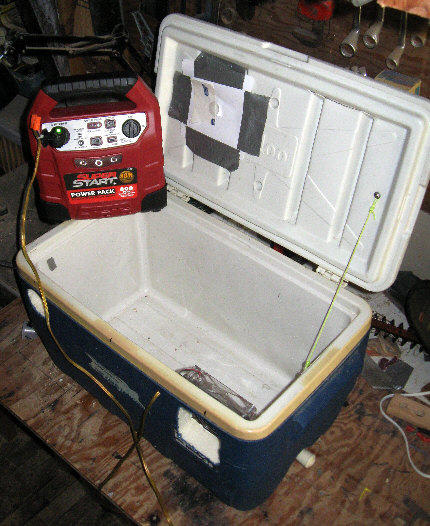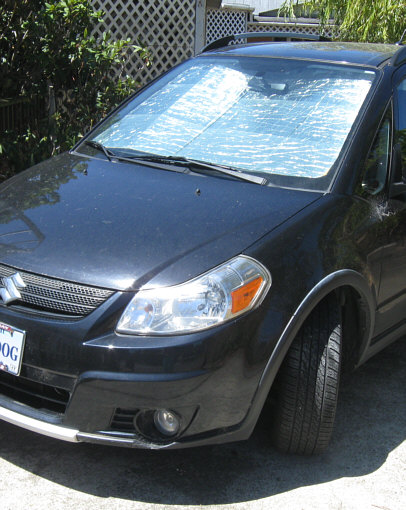Children, Pets and Devices At Risk
--in closed up, parked cars.
This page recounts our own efforts to control the interior
temperature of our 4 door compact car
(a Suzuki SX4) in order to keep our dog Sammy safe and
comfortable while he patiently waits for us.
You're at: https://57296.neocities.org/car.htm
Use "Ctrl" and tap "+" for larger text.
last worked on: May 20th, 2024a

5/20/2024 update: * I see that evaporative coolers for
cars are back --now 12 volt powered. From what I've seen (and
built), you need some sort of an ice chest based unit to make much
of a difference. Maybe adding ice to the evaporative units would work,
but make sure of that --before putting your dog at risk. Here are some
links:
https://www.walmart.com/search?q=evaporative+air+cooler+car+12+volt
https://www.youtube.com/watch?v=5k7HDtVnFeQ&t=17s
https://www.youtube.com/watch?v=XJzEA3Uucpk&t=641s
You might want to power it with a battery booster box
--to be sure that you won't run your old car battery down --and especially
if accessory 12 volt power goes out or times out with your ignition key
removed. (Check on, comfort your dog often and give him/her a nice cool
drink from the melted ice.)
* Note: After the ice melts, in order for an evaporative
("swamp") cooler to work, it needs fresh/dryer air, so you have to crack
your windows open a bit.

** My first thought: it seems a do-able engineering
assignment to design cars with ventilation --both low in the doors and
high near the roofs, such that air convection would flow in proportion
to the interior heat build up.
* But on second thought, a practical exhaust port would
probably need to be integrated into the roof: low profile but wide enough
to provide enough ducted convection flow, rear facing and stepped to avoid
storm water incursion.
* Third thought: the most likely practical approach
would be to modify the usual venitlation/exhaust system in existing cars
and trucks to actively respond to an overheated interior --perhaps with
energy efficient bypass fans and valves, for which the amp-hour capacity
of a standard car battery would be sufficient to run it for days.
* Any related air valving that's electrically operated
should default to open.
* Such a ventilation feature would eliminate that nagging
compromise between leaving your car securely locked up --versus adequately
ventilated. Motor vehicles should have always had such a basic safety feature.
While children should never be left in a car (and car
manufacturers, ventilated or not, must be careful to stipulate that), we
do see heart wrenching accounts of dead babies and pets. Passive and/or
active interior cooling would surely help to prevent those tragedies.
* Presumably, this would involve a switch-off-able
option for the thermostatically controlled forced ventilation, but only
with a warning for doing so. Although the heat gain of a closed car can
be ferocious, car interiors are a small space and modern muffin fans take
very little power --compared to the capacity of a vehicle battery.
* Aside from the drain of forced ventilation, every
car owner will eventually kill his/her battery or let it run down, so how
about being able to switch in a second "reserve"/standby/"booster" battery
--which would be a "Godsend" feature, which would in itself sell cars and
even save the lives of (otherwise) stranded people.
* Another option to explore would be to run ventilation
fans with solar cells or the Peltier effect ("thermal couples").

"Cracking the windows a bit" is a pathetically lame
way to cool a parked car.

* Several years ago, in preparation for going to our
county fair --which is well inland from our west coast location and often
very hot at that time of the year, I rigged a picnic type cooler chest
with a medium sized 12 volt muffin fan. It had an intake port, exhaust
port, and an extension cable for cigarette lighter power.
 Using a wired remote sensing (home type, indoor-outdoor)
thermometer, a big bag of ice in the cooler, and bowl of drinking water,
I was satisfied that our dog could be kept cool and comfortable for several
hours. (He actually moved a short distance away from this rig --too cold,
but kept his nose near the cool exhaust.)
Using a wired remote sensing (home type, indoor-outdoor)
thermometer, a big bag of ice in the cooler, and bowl of drinking water,
I was satisfied that our dog could be kept cool and comfortable for several
hours. (He actually moved a short distance away from this rig --too cold,
but kept his nose near the cool exhaust.)
* Unfortunately, our next car (a bargain priced, used,
2008 Suzuki) had a lighter socket that turned off with the ignition --plus
the doors can't be (electrically) locked with with accessory power left
on. Consequently, we bought a "jumper box" (a lightweight portable battery
unit with an internal charger) from an auto supply store --that has a cigarette
lighter type receptacle (above photo).
** That way there's no concern about running down the
car's battery. (The fan only takes half an amp).
* In order to be very sure this arrangement would work
in our Suzuki, I got ready to graph the results.

(*click* to enlarge)
* July 28, 2016: Unfortunately, our outside temperatures
simply don't get "hot", plus we have gusty winds, so I thought it not worth
the while to run the ice chest air conditioning test, but I did graph the
windshield reflector's effect.
 I'll try to add another graph or two if we ever get some
hot weather and calm air here.
I'll try to add another graph or two if we ever get some
hot weather and calm air here.
* If you try this idea, be sure to prove to yourself
that it and your methods work (in your car) before putting a pet at risk.
(We just never leave little kids alone in the car --right?) When satisfied
of its effectiveness, be sure to place a clearly written notice (or two)
where concerned people will see it --stating that the dog is cool and comfortable.
Include your cell phone number to use --in case anyone thinks otherwise
--lest some do-gooder or policeman busts a side window in order to liberate
your dog.
1/22/2017 update: It doesn't look like we'll ever again
be going to the fair (we're too old and feeble, plus it's no fun for our
dog Sammy), and it just doesn't get hot here (near the ocean), so I've
not run any more tests. (Sorry.)
Craig






